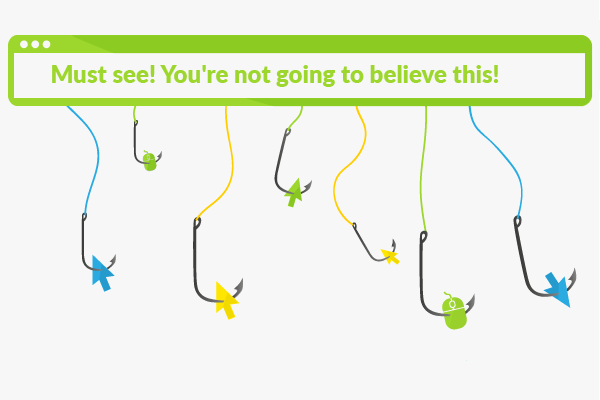Clickbaiting
Clickbaiting is a practice in online media that is used in blogposts, news, and videos. Different types of content are given titles that attract the attention of users and encourage them to click and share the content on social media.
The titles should act as bait for the user and ensure interaction in the form of clicks. However, critics often argue that the content behind the headlines are manipulative and usually banal with no direct added value for the user.[1]
General information
Clickbaiting is not a new form of communication. Exaggerated titles in print magazines and tabloids employ a similar principle. Cliffhangers in the television and film industry also function in the same way. Clickbaits are meant to make the user curious. Clickbaits should promise the user something that they gets with a single click on the post. It is not about the presentation of a product or a service and also not about helpful information.
It is more about trying to increase traffic on the particular platform in order to monetize the website afterwards with the placement of online advertisements.
Functionality
Every online medium has its own formula for gaining more clicks. In most cases, the headlines play with the curiosity of the users and appeal to certain impulses, emotions, and thoughts.[2] Something that is incredible, authentic, or unexpected is promised and communicated through specific signal words.
The basic structure of clickbaits
A brief introduction explains what is at stake. The main piece of the content mostly contains viral videos or lists of photos (listicles) with short explanations. The post is then concluded with a summary that has a take-home message for the user. This also entails integrating like, share, and comment buttons in clickbait posts to try and make the user interaction as simple as possible.
The structure, tone, and choice of words arouse different psychological effects in the user such that, with a very high probability, the user ends up clicking on the post and even sharing it on social media. Similarly, contentious, polarizing, or very emotional issues are also communicated, as users generally have a specific opinion about such content. The issue is presented from a very unusual point of view that contradicts the opinion of the users. A cliffhanger tells the beginning of the story. The end is only revealed when the user clicks on the post.
Common elements of clickbaiting
- Establishing shot: An ordinary state creates normalcy.
- Unexpected events: Something incredible suddenly happens.
- Cliffhanger (Zeigarnik effect from psychology): Then this or that happened. But what happened is not mentioned in the title.
- Call-to-action: In most cases, elements are also used to entice the user to click such as 'do not miss out' or 'must see'.
- Strong adjectives: unbelievable, startling, heartbreaking, etc.
- Superlatives: the best, the greatest, or the most unimaginable.
- Active verbs: learning, exploring, laughing, or crying.
- Internet slang: OMG, WOW, or LOL act as eye catchers in headlines and as identification with the internet community.
- Numbers: Numbers stand out from the text and generate attention. They are mostly used in lists.
Importance for social media
In recent years, clickbaiting has increasingly become a topic of discussion. Journalists complain about the quality and usefulness of clickbait posts, since they often only present a short entertainment treat for users. On the other hand, advocates identify clickbaiting with a new form of online communication that accurately satisfies the psychological needs of users.
In terms of the monetization of such websites, the success rates prove the advocates right. Portals, such as Buzzfeed, Upworthy, or the German clone heftig.co, generate so much traffic that they are among the most popular sites on the net. However, they sometime achieve this through content aggregation. For example, images and videos from third parties are only augmented with comments and conclusions in order to distribute them within the Internet community in social media. From a copyright point of view, this is questionable at the very least.[3]
The added value for the user is also doubted by Facebook. In August 2014, the company changed the algorithm of the news feed in order to regulate the traffic for clickbaits. Facebook wants to measure the time spent by a user with such a post and integrate this in the news feed algorithm. Social signals, such as likes, shares, and comments, are also scaled in order to identify the importance of such posts for the user.
The explanation: Clickbait headlines promise the user something that he/she does not find in the article. False facts are faked, and users prefer headlines that inform them about the content of the post.[4] Thus, the traffic of portals used by clickbaiting in the social network could be reduced by changing the news feed.
References
- ↑ Saving Us From Ourselves: The Anti-Clickbait Movement thedailybeast.com. Accessed on 12/08/2014
- ↑ The Secret Psychology Of Online Persuasion de.slideshare.net. Accessed on 12/08/2014
- ↑ The dirty secrets of clickbait. This post will blow your mind! econsultancy.com. Accessed on 12/08/2014
- ↑ News Feed FYI: Click-baiting newsroom.fb.com. Accessed on 12/08/2014
Web Links

